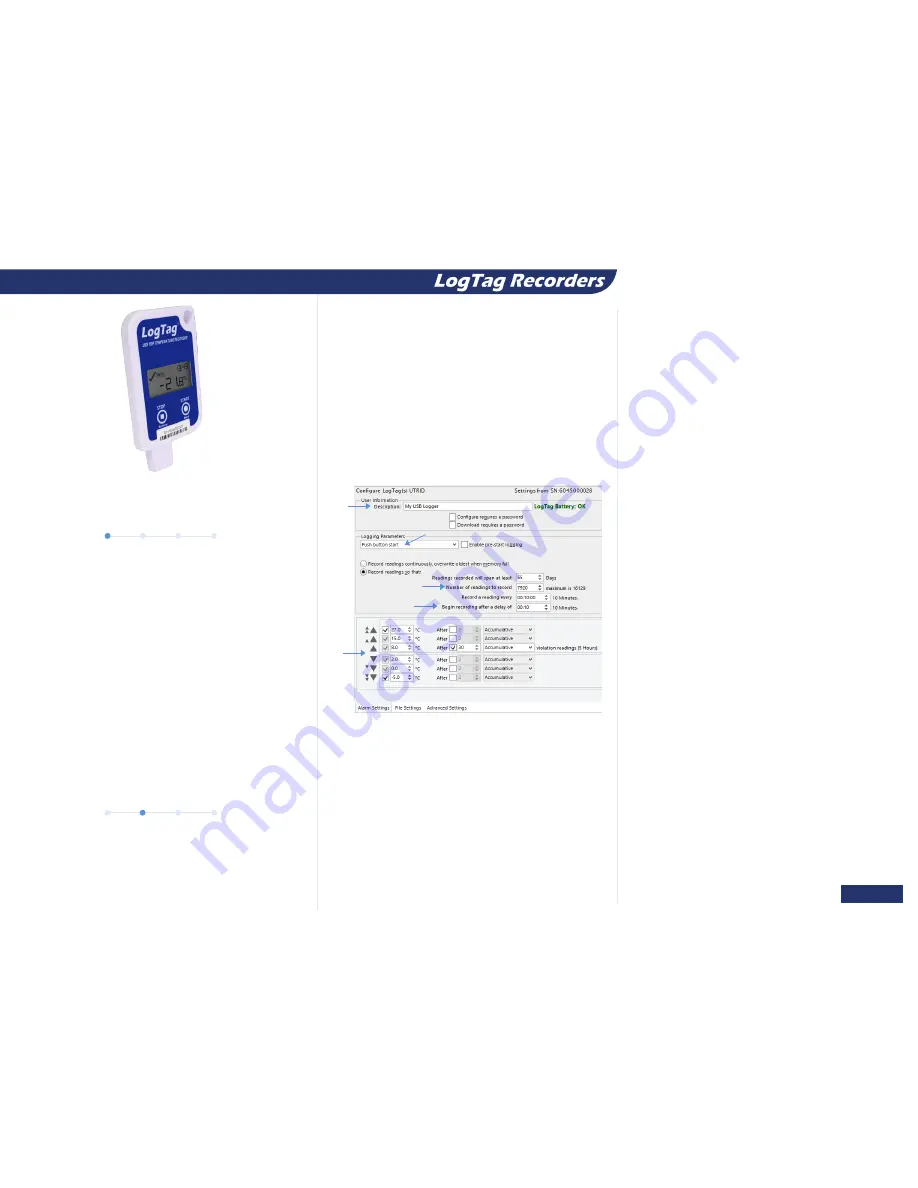
This quickstart guide covers preparation,
use and maintenance for the following model:
UTRID-16
1. SOFTWARE SETUP
2. LOGTAG
®
CONFIGURATION
Software requirements vary depending on the type of file you want it to
generate when plugged into a USB port.
Loggers can be ordered pre-configured, ready to start. Different
profiles are available; if none of these suit or the logger needs different
configuration settings to those already installed, you will need to
download and install our freely available companion LogTag
®
Analyzer
(version 2.8 or higher) software from our website: www.logtagrecorders.
com/software. Simply browse to our software page, fill in your details and
begin your download.
Once it has finished downloading, install LogTag
®
Analyzer to your
computer and start the program once it is installed. (For detailed
software download and install instructions, please refer to the LogTag
®
Analyzer User Guide).
It is recommended that you connect each USB PDF Temperature logger
via a permanently plugged in USB extension cable to protect your
computer’s USB socket. Please refer to
www.logtagrecorders.com/support if you are having issues.
With the Software running, the easiest way to configure your LogTag
®
for use is with the ‘
LogTag Wizard
’ which can be accessed by
pressing the ‘
F2
’ key on your keyboard or you can browse via the top
navigation menu: ‘
LogTag
’
>
‘
Wizard
’
Note:
You can configure many devices at the same time, however,
it is practical to limit the number of devices to about 10, using a
powered USB hub. It is not possible to configure different models at
the same time.
Advanced Configuration Options
Click
Advanced Settings
for additional configuration settings.
These settings decide which files -if any- are generated at the end
of the trip and also determine the appearance and contents of the
generated files.
Alarm Configuration
You need to observe some basic rules when entering alarm
conditions into the configuration screen in LogTag
®
Analyzer:
•
A primary alarm condition must be entered before the
corresponding secondary alarm condition.
•
Equally, primary and secondary alarm conditions must be entered
before the corresponding tertiary alarm condition.
•
You can enter a different number of upper and lower conditions,
or only upper, or only lower conditions, or none at all.
•
A secondary upper alarm cannot be entered with a lower
threshold value than the primary upper alarm.
•
A tertiary upper alarm cannot be entered with a lower threshold
value than the secondary alarm. Threshold values can, however,
be equal and combined with different time-to-activation values.
For example, you can enter a primary upper alarm with 8°C
threshold and 10 accumulative readings, plus an alarm with 8°C
threshold and 5 consecutive readings. In this instance the alam
will be triggered, if either 10 readings in total are above 8°C, or 5
consecutive readings above 8°C have occurred.
Any alarm condition that is activated will be shown on the PDF, in the
software and on the display.
“Standard Configuration”
UTRID-16 Quickstart Guide
Page 1 of 3
1. Provide a ‘Description’ to identify the logger being configured.
2. Select Push button or Time/Date start.
3. Enter the recording interval you wish to use. The duration
of the shipment and/or number of readings to record changes
according to the recording interval entered.
4. (Optional) Enter a start delay before the logger begins recording.
5. LogTag
®
Analyzer allows up to 6 different alarm trigger conditions
when configuring a UTRID-16 for recording, depending on the
model. Each alarm trigger condition consists of a threshold
temperature value, an activation type (which can be instant,
1
2
3
4
consecutive or accumulative) and a delay time, if it is not an
instant alarm. The UTRID-16 can have up to three upper alarms,
and up to three lower alarms.
5



